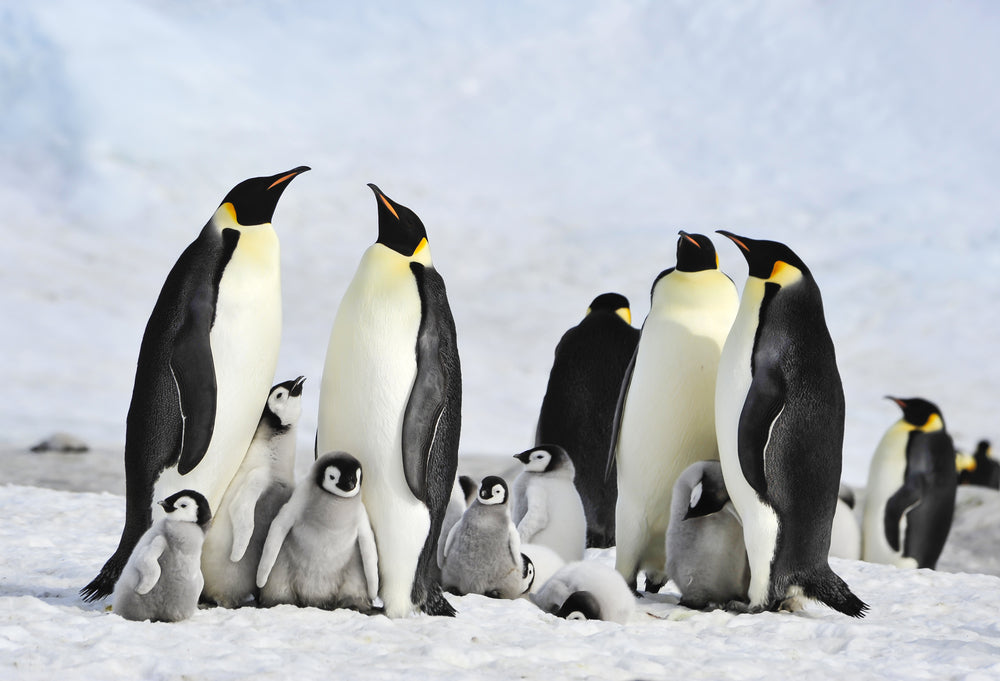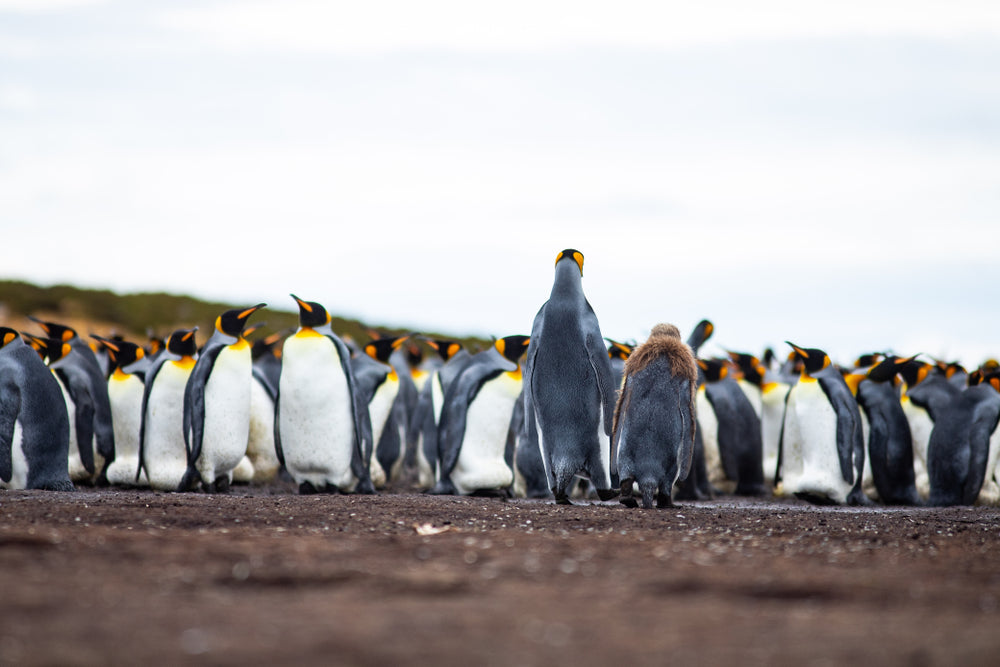Penguins! These adorable flightless birds are cherished by adults and kids alike for their funny ways and their tuxedo-like outfits. The penguin lifestyle is fascinating and their behavior is extraordinary.
A group of these amazing creatures is called a penguin colony, unless the group is floating in the ocean - then it’s known as a “raft.” Penguins mainly feed on krill and fish. They can stay underwater for up to 20 minutes, and dive as deep as 500 meters.
A colony of penguins may look (and sound) like it’s utter chaos, yet parents and chicks can find each other amongst thousands despite the noise. It’s not done visually. Penguins find each other because of an incredible ability to recognize the individual calls of their mates and their babies.
Seventeen distinct penguin species exist in the world. Not all of these penguin species live in the Antarctic, but that’s the area most people associate with these unique birds. Due to several recent events, some experts are asking a troubling question: Could the Antarctic region lose most of their penguins?
There’s a good reason this question is weighing on the minds of many researchers and environmentalists. It’s because of the disturbing decline of colonies within three specific penguin species - Emperor penguins, King penguins, and Adélie penguins. It’s serious enough that the losses have made international headlines.
Naturally, these three separate examples of penguin colony decline raise questions about the effects of climate change on the species. Are we definitely losing penguins to climate change? Could there be other reasons the penguin habitat is disappearing? Is intervention by humans on the fate of penguin colonies, climate change aside, a feasible solution?
Here are the backstories:
1. Emperor penguins are the largest of the species. The Emperor penguin decline leaped into the news a few years ago when it was revealed that the second-largest Emperor penguin colony in the world is nearly gone.
The British Antarctic Survey’s researchers reported that thousands of Emperor penguin chicks drowned in 2016. They explained, “Emperor penguins need stable sea ice on which to breed and this icy platform must last from April, when the birds arrive, until December, when their chicks fledge.”
Sea ice in one Antarctic area called the Weddell Sea on the edge of an ice shelf was destroyed by storms in 2016, and then storms recurred in 2017 and in 2018. "Emperor penguins at the Halley Bay colony in the Weddell Sea have failed to raise chicks for the last three years," said one co-author of the report. "The colony has now all but disappeared."
2. King penguins are the second tallest of the penguin species. It appears there’s been a tremendous decrease in the largest king penguin colony too, the colony on France’s Île aux Cochons (Pig Island).
Located between the southernmost tip of Africa and the Antarctic, it’s been estimated that over the last 30 years, this King penguin colony decline is now fixed at 85 to 90%. Researchers say the colony was at one time nearly one-third of the king penguins in the entire world.
The rapid decline could be due to climate change or disease, or because resources have become more scarce. Hopefully, more information will be revealed when a late autumn 2019 research expedition to the location takes place.
Scientists haven’t actually been on the Island since the 1980s. At that time, there were an estimated 2 million King penguins living there. That number included almost a half million breeding pairs. By 2018, estimates made using satellite imagery and photos from helicopters dropped to an alarming 200,000 birds in total.
There’s no human colonization there, and the pigs that had been introduced at one time have been exterminated. Some cats and mice inhabit the area, but scientists say it’s not likely those have anything to do with what’s causing this decline.
One biologist finds the situation especially puzzling since king penguins in other locations are doing fine. But he does point out that due to global warming, the penguins in this colony may have to travel farther south than they did previously in order to find sufficient food.
3. Adélie penguins are yet another Antarctic penguin group that’s been in trouble. This time the problem was a giant iceberg that left the penguin colony landlocked. A colony of 160,000 penguins now appears to only number 10,000.
The penguins of Cape Denison, who’ve been recorded in that area for over 100 years, used to live close to a large body of open water. In 2010, a huge iceberg became trapped in their bay. Due to the landlock, the penguin colony essentials of food and open water ended up being 60 to 100 kilometers away.
Sea ice in that area has since broken up, but two times in four years the colony suffered massive changes to the population. The combination of an “unprecedented” rainy period along with the presence of summer sea ice has been blamed. Evidence points to starvation, a large number of unhatched eggs, and an inability of the chicks to stay warm when wet.
Because of these unhappy events with Adélie penguins, there have been pressing demands for new marine protected areas in East Antarctica, similar to the world’s largest marine protected area which is in Antarctica’s Ross Sea.
The World Wildlife Federation (WWF) is asking for waters of East Antarctica to be off limits for industrial fishing and the harvesting of krill. Their hope is that this will eliminate competition for food sources that the penguins must have to survive.
Addressing climate change to save the penguin population

Finding solutions to limit climate change could play a role in ending these population declines. The terms climate change and global warming are sometimes used interchangeably, but they’re not the same. Global warming is just one facet of what can take place within overall climate change.
One agency (NASA) that studies Earth's natural systems, keeps long-term data, and shares knowledge with institutions around the world, helps us differentiate between the two terms:
Climate change refers to a broad range of global phenomena created predominantly by burning fossil fuels, which add heat-trapping gases to Earth’s atmosphere. These phenomena include the increased temperature trends described by global warming, but also encompass changes such as sea level rise; ice mass loss in Greenland, Antarctica, the Arctic and mountain glaciers worldwide; shifts in flower/plant blooming; and extreme weather events.
Global warming refers to the long-term warming of the planet since the early 20th century, most notably since the late 1970s, due to the increase in fossil fuel emissions since the Industrial Revolution. Worldwide since 1880, the average surface temperature has gone up by about 1 °C (about 2 °F.)
When you examine the face of climate change today, it’s clear there’s still a battle raging about the causes and the solutions. Frustration is evident on all sides.
Some think the impact of climate change is related to natural cycles. Some of that group even declare that climate change is the worst scientific scandal of our generation and that there’s a conspiracy of slanting the data to make things look catastrophic. On the other side of the argument, there’s a growing body of data that seems to clearly indicate the effects of climate change are a sure path to disaster.
Additionally, there’s the discouragement of getting everyone on board to arrest even the most basic and obvious problems that everyone agrees on. Even though the U.S. is often vilified as a high energy consumer, they’ve put regulations in place while the fossil fuel Co2 emissions in China are nearly twice as high as they are in the United States.
Environmentalists and biologists aren’t the only scientists debating these important topics. If you’ve wondered about the role of physics in these discussions, rest assured that physicists and climate change issues are well acquainted!
The American Physical Society states the following position on global warming and climate change: "Emissions of greenhouse gases from human activities are changing the atmosphere in ways that affect the Earth's climate."
When nature and climate change threaten penguins or any other species, it’s essential to take the necessary actions and educate the public to protect fragile habitats while they can still be spared.
One practical example is related to the penguins’ primary food source, krill. There is potential for krill to become endangered because of a growing industry that utilizes krill oil for health supplements. Regulations and programs are being discussed to control commercial fishing for krill.
Are there reasons for hope?

There are some bright spots in the plight of these interesting creatures. The location of a penguin colony doesn’t always remain static. Migration to other locations is possible, although not always an option if no suitable islands are within a reasonable range. But there are some colonies who recently appear to have made this journey with success.
A new “supercolony” of Adélie penguins (1.5 million of them) has been discovered living and nesting on the Danger Islands near Antarctica, substantially increasing the known populations of these astonishing creatures.
There’s been a tremendous increase in the population of Emperor penguins 34 miles south of Halley Bay, leading researchers to suggest that many of the Emperor penguins from the Halley Bay colony collapse had indeed been able to successfully relocate.
King penguins, who live on ice-free land rather than on sea ice, can swim up to 500 kilometers to feed. This could be the principal factor in their survival because if they were able to find a new home within reach of food, king penguins could re-populate steadily.
If they’re able to find alternate locations, stay within reach of adequate food supply, and avoid competition for food with other wildlife, penguin numbers could once again be significant. The use of satellite imagery or drones would be a non-invasive way to monitor the population, and assure ourselves that the penguin colonies are healthy again.
